| |
Predicting risk of dementia in older adults.
The late-life dementia risk index - Aging !!!!
|
| |
| |
Neurology May 13 2009
from Jules: the results of this highly publicized new study, its on all the news, suggests HIV+ individuals have many of these risk factors and are at higher risk for developing dementia. But in addition there are additional potential risk factors that HIV+ individuals may possess that have been discussed by HIV neurological researchers that include the way in which HIV itself may be associated with characteristics associated with alzheimer's disease and dementia. At CROI this year 2009 there were many studies reported finding increased risk for cognitive impairment and neurological disease among HIV+ individuals. In all, this is another reason the NIAID and HIV researchers should be strongly focused on aging research NOW to try to uncover the risk and possible interventions. Of course HIV appears associated with accelerating additional diseases including bone disease, kidney disease, cancers, and heart disease BUT research into how HIV itself accelerates these diseases is not ONGOING. We need basic research now to understand and hopefully prevent premature deaths in HIV. As you know in the past 2-3 years large cohort studies like DAD & EuroSida have shown increased comorbidities at early ages and associated with increased death rates at early ages in HIV+, which suggests strongly I think that soon we may be seeing significantly increased death rates at early ages in HIV+ individuals. So what will it take to wake up our research community!!!
D. E. Barnes PhD, MPH*, K. E. Covinsky MD, MPH, R. A. Whitmer PhD, L. H. Kuller MD, DrPH, O. L. Lopez MD, and K. Yaffe MD
From the Departments of Psychiatry (D.E.B., K.Y.), Medicine (K.E.C.), Neurology (K.Y.), and Epidemiology & Biostatistics (K.Y.), University of California, San Francisco, and San Francisco Veterans Affairs Medical Center; Kaiser Division of Research (D.E.B., K.E.C., R.A.W., K.Y.), Oakland, CA; and Departments of Epidemiology (L.H.K.) and Neurology and Psychiatry (O.L.L.), University of Pittsburgh, PA.
* To whom correspondence should be addressed. E-mail: Deborah.Barnes@ucsf.edu.
"The late-life dementia risk index also could be used clinically to identify older adults who do not currently have overt dementia symptoms but who should be monitored more closely for signs of cognitive impairment. Those individuals who develop dementia could then begin treatment as soon as possible, potentially enabling them to maintain their cognitive function and quality of life for as long as possible."
"A wide range of factors were associated with an increased risk of dementia after adjustment for age, sex, education, and race, and were considered for inclusion in the late-life dementia risk index. These included demographic factors (older age, lower education, lower income); low cognitive test scores (although specific cutpoints differed by race and education groups); comorbid medical conditions (angina, bypass surgery, PAD, hypertension, stroke, TIA); self-reported physical function; directly assessed physical performance; health behaviors (lack of alcohol consumption, low physical activity, BMI <18.5); high depressive symptoms; poor social network; MRI evidence of infarcts, white matter disease, or ventricular atrophy; evidence of carotid artery stenosis; low self-rated health; three or more medications; low ankle-arm index; APOE e4 genotype; and high creatinine levels....
....When we considered all of these factors simultaneously, those that emerged as being most predictive of dementia and were retained in the final late-life dementia risk index included older age, worse cognitive function based on the 3MS or DSST, BMI <18.5, one or more APOE e4 alleles, MRI evidence of white matter disease or enlarged ventricles, ultrasound evidence of internal carotid artery thickening, slow physical performance based on time to put on and button shirt, history of bypass surgery, and lack of alcohol consumption. Unadjusted associations between these factors and dementia are shown in table 1....
...We then assigned points to each of these factors to create the late-life dementia risk index (table 2)."
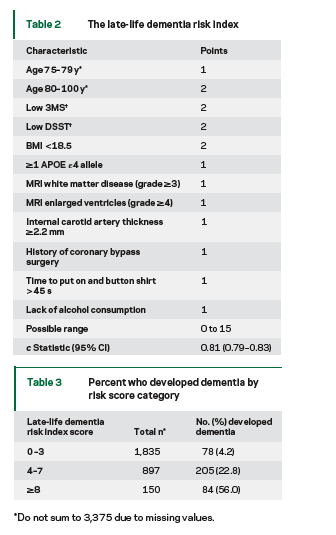
ABSTRACT
Objective: To develop a late-life dementia risk index that can accurately stratify older adults into those with a low, moderate, or high risk of developing dementia within 6 years.
Methods: Subjects were 3,375 participants in the Cardiovascular Health Cognition Study without evidence of dementia at baseline. We used logistic regression to identify those factors most predictive of developing incident dementia within 6 years and developed a point system based on the logistic regression coefficients.
Results:
Subjects had a mean age of 76 years at baseline; 59% were women and 15% were African American. Fourteen percent (n = 480) developed dementia within 6 years.
The final late-life dementia risk index included older age (1-2 points), poor cognitive test performance (2-4 points), body mass index <18.5 (2 points), ³1 apolipoprotein E {epsilon}4 alleles (1 point), cerebral MRI findings of white matter disease (1 point) or ventricular enlargement (1 point), internal carotid artery thickening on ultrasound (1 point), history of bypass surgery (1 point), slow physical performance (1 point), and lack of alcohol consumption (1 point) (c statistic, 0.81; 95% confidence interval, 0.79-0.83). Four percent of subjects with low scores developed dementia over 6 years compared with 23% of subjects with moderate scores and 56% of subjects with high scores.
Conclusions: The late-life dementia risk index accurately stratified older adults into those with low, moderate, and high risk of developing dementia. This tool could be used in clinical or research settings to target prevention and intervention strategies toward high-risk individuals.
GLOSSARY
3MS _ Modified Mini-Mental State Examination; AD _ Alzheimer disease; ADL activities of daily living; BMI body mass index; CABG_coronary artery bypass graft; CART_Classification And Regression Tree; CES-D Center for Epidemiologic Studies-Depression Scale; CHF congestive heart failure; CHS Cardiovascular Health Study; CI _ confidence interval; DSST Digit Symbol Substitution Test; IADL instrumental activities of daily living; MCI mild cognitive impairment; MI myocardial infarction; NPV negative predictive value; PAD peripheral artery disease; PPV positive predictive value; ROC receiver operating characteristic; UES upper extremity strength.
Prognostic indices are tools that can be used to identify individuals who have a low, moderate, or high risk of experiencing a given event within a given time frame. Commonly used prognostic indices include the Framingham Heart Index1,2 and the Breast Cancer Risk Assessment Tool3,4; other tools are available to predict risk of diabetes5 and overall mortality,6,7 among other conditions. One recent study found that midlife vascular risk factors could be combined to predict risk of dementia 20 years later.8 However, there is not currently a tool available to predict dementia risk in late life.
A late-life dementia risk index could have several important uses: it could be used to identify high-risk individuals for clinical trials and to target preventions toward those at greatest risk; to identify older adults who should be monitored for new dementia symptoms, so that treatments could be initiated at the earliest possible stage of disease; and to provide information to concerned patients or their family members.
The primary objective of our study was to develop a late-life dementia risk index that could be used to accurately stratify older adults into those with low, moderate, or high risk of developing dementia within 6 years.
RESULTS
Subjects had a mean age of 75 years at baseline; 59% were women, 15% were African American, and 76% had 12 or more years of education. Fourteen percent (n = 480) of subjects developed dementia over the 6 years of follow-up; of
these, 245 (51%) had AD, 62 (13%) had vascular dementia, 151 (31%) had mixed dementia, and 22 (5%) had other forms of dementia.
A wide range of factors were associated with an increased risk of dementia after adjustment for age, sex, education, and race, and were considered for inclusion in the late-life dementia risk index. These included demographic factors (older age, lower education, lower income); low cognitive test scores (although specific cutpoints differed by race and education groups); comorbid medical conditions (angina, bypass surgery, PAD, hypertension, stroke, TIA); self-reported physical function; directly assessed physical performance; health behaviors (lack of alcohol consumption, low physical activity, BMI <18.5); high depressive symptoms; poor social network; MRI evidence of infarcts, white matter disease, or ventricular atrophy; evidence of carotid artery stenosis; low self-rated health; three or more medications; low ankle-arm index; APOE e4 genotype; and high creatinine levels.
When we considered all of these factors simultaneously, those that emerged as being most predictive of dementia and were retained in the final late-life dementia risk index included older age, worse cognitive function based on the 3MS or DSST, BMI <18.5, one or more APOE e4 alleles, MRI evidence of white matter disease or enlarged ventricles, ultrasound evidence of internal carotid artery thickening, slow physical performance based on time to put on and button shirt, history of bypass surgery, and lack of alcohol consumption. Unadjusted associations between these factors and dementia are shown in table 1.
We then assigned points to each of these factors to create the late-life dementia risk index (table 2). The final index had a maximum possible score of 15 points and a c statistic of 0.81 (95% CI: 0.79-0.83). The negative predictive value (NPV) (using a threshold of 0.5 or greater to indicate dementia) was 90% while the positive predictive value (PPV) was 56% for a combined total of 88% correctly classified. Four percent of subjects with low scores developed dementia within 6 years compared with 23% of subjects with moderate scores and 56% of subjects with high scores (table 3). Results were similar using the beta coefficients from the model rather than a point system to predict dementia risk (c
statistic, 0.82; 95% CI: 0.79-0.84; NPV, 89%; PPV, 57%; 88% classified correctly).
The calibration of the final late-life dementia risk index is shown in the figure. The predicted probability of dementia was closely aligned with the actual percentage of subjects who developed dementia across the full range of scores.
Validation. Our results were identical using the 10- fold cross-validation approach (c statistic, 0.81; 95% CI, 0.79-0.83). Predictive accuracy did not differ by gender, race, education, or baseline 3MS score but was slightly higher in those who were younger (c statistic [95% CI] = 0.79 [0.75- 0.83] for those age
65-74 compared with 0.76 [0.71- 0.80] for those age 75-79 and 0.73 [0.68-0.78] for those age >/=80; p for interaction, 0.07) and in those without an APOE e4 allele (0.82 [0.80-0.85] for those with 0 APOE e4 alleles compared to 0.76 [0.71- 0.81] for those with >/= 1 APOE e4 alleles; p for interaction, 0.04). Accuracy also was higher for mixed dementia (0.86 [0.83- 0.89]) than for AD (0.79 [0.76-0.82]) or vascular dementia (0.79 [0.72- 0.86]), although it remained high in all of the subgroups examined.
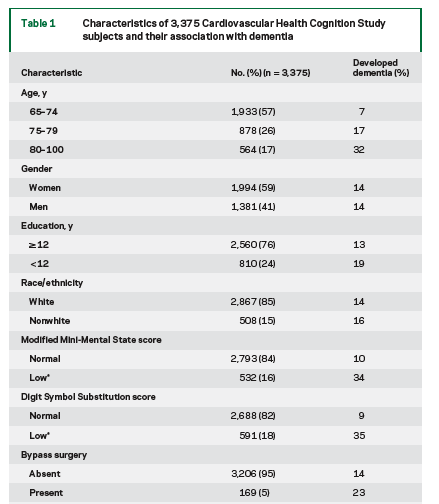
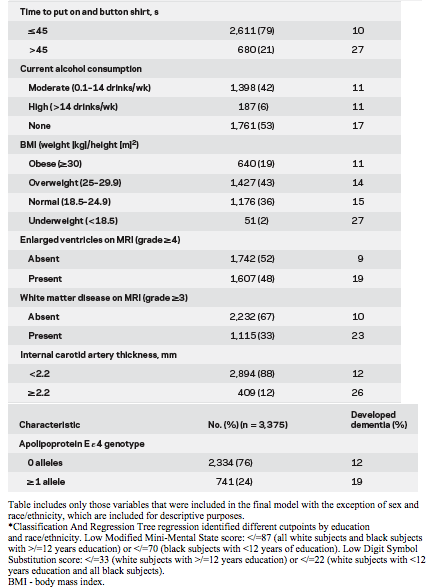
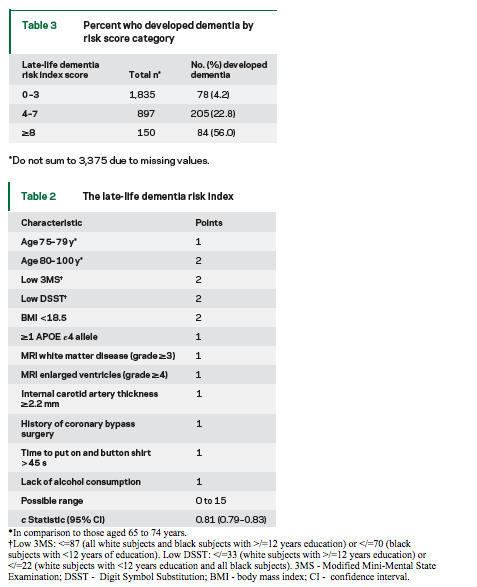
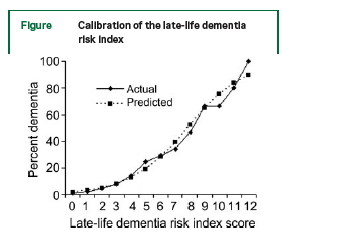
The calibration (predicted vs actual risk) of the late-life dementia risk index is shown by plotting the actual percentage of subjects who developed dementia (solid line) and the
predicted risk of dementia (dashed line) as a function of participants' risk scores. The index shows high congruence between actual and predicted risk across the full range of
scores.
DISCUSSION
In this community-based study of adults aged 65 years or older, it was possible to accurately stratify participants into those with low, moderate, or high risk of developing dementia within 6 years. The risk of dementia was less than 5% in those with low scores on the late-life dementia risk index and more than 50% in those with high scores.
The accuracy of our late-life dementia risk index (c statistic, 0.81) was higher than the accuracy of the midlife dementia risk index previously developed (c
statistic, 0.78).8 This may suggest that it is easier to predict dementia risk closer to symptom onset, or it may be a function of the relatively simple measures
used in the midlife index. However, the absolute difference in accuracy between the two indices was relatively small, suggesting that simple tools may provide
important alternatives when time or resources are scarce.
Most of the specific items included in the late-life dementia risk index were not surprising and have been identified as dementia risk factors in CHS and
other cohorts. The most predictive variables were older age and worse cognitive test performance, both of which are well-established as important risk factors for dementia.24-26 The identification of different cutpoints for low cognitive function based on race and educational levels in our study may reflect cultural or educational test biases or other factors.
Our late-life dementia risk index also included several measures of vascular disease, which is consistent with the growing consensus that vascular disease
may exacerbate or contribute to the manifestation of symptoms in dementia.27-29 The specific items identified also are consistent with the findings of a prior
CHS study in which subjects with a combination of >/=1 APOE e4 allele, 3MS <90, ventricular enlargement, and white matter disease were 17 times more
likely to develop dementia than those with none of these factors.9 The presence of both vascular and nonvascular items in the index may explain why accuracy
was greatest for cases of mixed dementia.
The other factors that emerged as being important predictors of dementia risk included low BMI, slow physical performance, lack of alcohol consumption, and
history of coronary bypass surgery. These factors also have been identified in some prior studies,30-35 although it is unclear whether they are simply good markers of dementia risk or reflect etiologic risk factors.
The late-life dementia risk index may have several important clinical and research uses. It could be used to identify high-risk individuals for clinical trials of new intervention and prevention strategies, thereby minimizing the costs and maximizing the statistical power of these trials. In addition, once successful interventions and preventions are developed, it could be used to target them toward those who are at greatest risk.
The late-life dementia risk index also could be used clinically to identify older adults who do not currently have overt dementia symptoms but who should be monitored more closely for signs of cognitive impairment. Those individuals who develop dementia could then begin treatment as soon as possible, potentially enabling them to maintain their cognitive function and quality of life for as long as possible.
Finally, many individuals and their family members are concerned about their risk of developing dementia, and this concern can greatly affect quality of life for these individuals. The late-life dementia risk index could be used to reassure those individuals whose risk is low or moderate and to provide those individuals whose risk is high with information that may help them better prepare and plan for their future.
Strengths of this study include the large, biracial study population and number of potential predictors considered for inclusion. There also are several limitations. First, dementia status was determined retrospectively by an adjudication committee of experts. Second, it is possible that predictive accuracy could be even greater using other variables (e.g., hippocampal volume, other biomarkers, different cognitive tests), change in cognitive function (rather than performance on a single day), or continuous measures for some variables (e.g., age). Third, some of the items in the late-life dementia risk index may be difficult to measure in some settings. We currently are performing additional analyses to determine whether a shorter, simplified index may have similar predictive accuracy. Finally, it will be important to validate the late-life dementia risk index in other study populations.
METHODS
Study population. The study population was participants in the Cardiovascular Health Cognition Study,9,10 which is nested within the larger Cardiovascular Health Study (CHS).11 CHS was initiated in 1989-1990 as a prospective, population-based, longitudinal study of risk factors for coronary heart disease and stroke in 5,888 adults aged 65 years and older: 5,201 primarily white and African American subjects were enrolled in 1989-1990, and an additional 687 African Americans were enrolled in 1992-1993. Subjects were recruited from randomized Medicare eligibility lists in four US communities: Forsyth County, NC; Washington County, MD; Sacramento County, CA; and Pittsburgh, PA.
In 1998-1999, the CHS Cognition Study was initiated as an ancillary study to identify subjects who had developed dementia or mild cognitive impairment (MCI) during followup. 9,10,12 The cohort included all 3,608 CHS study participants
who had a cerebral MRI scan and Modified Mini-Mental State Examination (3MS) in 1991-1994. A standardized protocol was administered across the four sites to classify subjects as having prevalent dementia at the time of the MRI examination or incident dementia or MCI from the time of the MRI to the end of the follow-up period (1998 -1999), death, or loss to follow-up. Our study excluded 227 subjects who had prevalent dementia at baseline and 6 subjects who had insufficient data to determine dementia status for a final sample size of 3,375 subjects without dementia at baseline. Participants who did not permit use of their DNA (n = 300) were excluded from analyses that considered genetic factors.
All study procedures were approved by Institutional Review Boards at the participating institutions, and all subjects provided written, informed consent. In addition, the analyses described here were approved by the Committee on Human Research at the University of California, San Francisco, and the Research Committee at the San Francisco VA Medical Center.
Dementia diagnosis. Dementia was defined as a progressive or static deficit in at least two cognitive domains that did not necessarily include memory and was of sufficient severity to affect the subjects' daily activities combined with a history of normal intellectual function. Dementia type was classified as probable or possible Alzheimer disease (AD) (National Institute of Neurological and Communicative Diseases and Stroke-Alzheimer's Disease and Related Disorders Association criteria), probable or possible vascular dementia (State of California Alzheimer's Disease Diagnostic and Treatment Centers criteria),
mixed dementia, or other. MRI findings were used to aid in classification of dementia type but not in the initial dementia diagnosis. All dementia cases were reviewed by an adjudication committee composed of expert neurologists and psychiatrists. Details of the dementia diagnostic process have been published elsewhere.9,10,12
Predictive measures. Although many different risk factors for
dementia have been identified, little is known about their relative
predictive values. Therefore, we considered a wide range of potential
predictive measures for the late-life dementia risk index. Details of how specific predictor variables were defined are included in the appendix on the Neurology Web site at www.neurology.org. Demographic factors included age, sex, years of
education, race/ethnicity, annual household income, and lifetime occupation. Cognitive function was assessed with the 3MS13 (a measure of global cognitive function with a maximum score of 100) and the Digit Symbol Substitution Test14 (DSST, a measure of attention and mental processing speed). Medical conditions included history of myocardial infarction (MI), angina, congestive heart failure (CHF), peripheral artery disease (PAD), stroke, TIA, hypertension, diabetes, angioplasty, and coronary artery bypass graft (CABG) surgery. Physical function measures included self-reported difficulty with one or more activities of daily living (ADL: ability to feed, dress, bathe, get out of bed/chair, or use the toilet independently), instrumental activities of daily living (IADL: ability to walk one-half mile, do light or heavy housework, shop, prepare meals, manage money, or use
the telephone), and upper extremity activities (UES: lifting, carrying, reaching, or gripping).15 Physical performance measures included gross motor function (number of steps and time to complete the 15-foot walk), fine motor function (time to put on and button a shirt), and ability to perform the tandem balance
stand.16 Lifestyle factors included current alcohol consumption (number of drinks of beer, wine, and hard alcohol per week), number of blocks walked during the past week, body mass index (BMI: weight [kg]/height [m2]), current smoking, and the number of hours/day spent seated or lying down. Psychosocial variables
included depression score (Center for Epidemiologic Studies-Depression Scale [CES-D] 10-item questionnaire),17 life events score (scale from 0 to 6),18 social network score (range: 1 to 50),19 and social support scale (range: 6 -22).20 Self-rated health was classified on a five-point scale from poor to excellent. Total number of prescription medications was determined based on a medication inventory. Cerebral MRI variables considered included presence of small (3 mm) infarctlike lesions, white matter disease, and ventricular enlargement.21 Carotid artery ultrasound variables included maximum thickness
of the common or internal carotid artery wall and maximum percent stenosis (classified as 0%, 1%-24%, 25%-49%, 50%- 74%, 75%-99%, or 100% based on the most severely affected vessel).11,22 Genetic predisposition was defined as presence of one or more APOE e4 alleles. Electrocardiogram measures included evidence of atrial fibrillation or any major abnormality. The ankle-arm blood pressure index was calculated by measuring blood pressure in the right arm and both ankles in the supine position after a 30-minute rest.11 Serum measures included albumin, cholesterol (total, high-density lipoprotein, low-density lipoprotein), C-reactive protein, creatinine, factor VII, fasting glucose, hematocrit, hemoglobin, fasting insulin, potassium, platelet count, triglycerides, and white blood count. For all predictive variables, values from the 1992-1993 examination were used.
Statistical analyses. We first examined the univariate distribution
of each variable and its bivariate association with dementia.
To maximize the ease of use of the index, all variables were
categorized and X2 tests were used to compare the frequency of
dementia across the categories. For variables that were originally
continuous or had multiple categories, we based our final categories on standard clinical cutpoints when available (e.g., anklearm index
All variables that were significantly associated with dementia in bivariate analyses (p <0.05) were then examined in logistic regression models adjusted for age (categorized as <75, 75-79, and >/=80 years), sex, education (dichotomized as <12 years vs >/=12 years), and race. Variables that remained associated with dementia after adjustment for demographics (p < 0.05) were then further examined in groups (e.g., all medical conditions together, all MRI measures together). The variables that were identified as being most predictive from each group were then considered together in multivariate logistic models using forward and backward stepwise selection procedures. Finally, a point system was developed based on the logit coefficients from the final logistic model. Variables with coefficients=0.75 were assigned 1 point while variables with coefficients >0.75 were assigned 2 points.
Predictive accuracy of the model was assessed based on discrimination and calibration. Discrimination refers to the ability of the index to accurately distinguish between low-risk and highrisk individuals and was assessed using the area under the receiver operating characteristic (ROC) curve, also known as the c statistic. The ROC curve is a graph of the true-positive rate (sensitivity) by the false-positive rate (1 - specificity), and it is related to the relative probability that in all possible pairs of subjects in which one had the outcome and one did not, the one with the outcome would receive a higher risk score. The c statistic may
range from 0 to 1: a c statistic of 0.5 indicates that predictive accuracy is no better than chance, while a c statistic of 1 indicates perfect discrimination. We also categorized subjects as having low, moderate, or high scores on the final late-life dementia risk index and calculated the percentage of subjects who developed dementia within each group.
Calibration refers to the extent to which predicted risk matches actual risk. We assessed this by plotting the predicted probability of dementia and the actual percentages of participants who developed dementia by their risk scores.
Validation. The final model was validated using a 10-fold cross-validation approach, in which the data were randomly divided into 10 groups and then the models were fit using nine groups and the c statistic was calculated in the remaining group. The mean c statistic and 95% confidence intervals (CI) were
then calculated directly from these 10 estimates. In addition, we performed sensitivity analyses in which we determined whether the predictive accuracy of the index differed by gender, race, education, baseline 3MS score, or APOE genotype by testing for interactions with these variables. We also compared the accuracy of the index for different types of dementia.
All analyses were performed using SAS version 9.1 (SAS Institute, Cary, NC) or Stata Version 9.2 (StataCorp, College Station, TX).
|
|
| |
| |
|
|
|